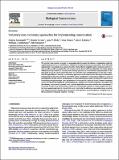Por favor, use este identificador para citar o enlazar a este item:
http://hdl.handle.net/10261/141736COMPARTIR / EXPORTAR:
 SHARE SHARE
 CORE
BASE CORE
BASE
|
|
| Visualizar otros formatos: MARC | Dublin Core | RDF | ORE | MODS | METS | DIDL | DATACITE | |

| Campo DC | Valor | Lengua/Idioma |
|---|---|---|
| dc.contributor.author | Santangeli, Andrea | - |
| dc.contributor.author | Arroyo, Beatriz | - |
| dc.contributor.author | Dicks, Lynn V. | - |
| dc.contributor.author | Herzon, Irina | - |
| dc.contributor.author | Kukkala, Aija S. | - |
| dc.contributor.author | Sutherland, William J. | - |
| dc.contributor.author | Moilanen, Atte | - |
| dc.date.accessioned | 2016-12-21T10:10:33Z | - |
| dc.date.available | 2016-12-21T10:10:33Z | - |
| dc.date.issued | 2016 | - |
| dc.identifier | doi: 10.1016/j.biocon.2016.03.013 | - |
| dc.identifier | issn: 0006-3207 | - |
| dc.identifier.citation | Biological Conservation 197: 209-214 (2016) | - |
| dc.identifier.uri | http://hdl.handle.net/10261/141736 | - |
| dc.description.abstract | The voluntary non-monetary approach to conservation refers to actions that citizens or organizations could voluntarily implement in their area of influence without the incentive of monetary compensations. To be effectively implemented by untrained actors, actions should be clearly defined, straightforward to implement and not require specific scientific knowledge. The costs of actions should also be sufficiently affordable to be widely applied without monetary incentives. A voluntary non-monetary approach has so far not been clearly described as a distinct group of tools for nature conservation. Here we review the scarce scientific literature on the topic. To illustrate the applicability of a voluntary non-monetary approach to conservation, we then investigate its potential for farmland conservation. We considered a list of 119 actions available from >conservation-evidence>, a source of systematically collected evidence on effectiveness of conservation actions. Among 119 actions, 95 could be scored for feasibility of implementation, costs, and existence of evidence in UK, Spain and Finland. Sixteen to seventeen actions were potentially suitable for implementation by a voluntary non-monetary approach. This implies that the voluntary non-monetary approach could be widely applicable across many countries and environments. It is our hope that this study will represent a clarion call for conservation scientists to clearly recognize the voluntary non-monetary approach, its characteristics, and its potential for addressing conservation issues on private land. Adoption of such voluntary measures may be more dependent on encouragement ('nudging') than on the usual coercive or financial emphasis ('shoving'). | - |
| dc.description.sponsorship | For support we thank Kone Foundation [A.S. and A.M.], the ERC-StG Grant 260393 (GEDA) [A.M.], the Finnish Natural Heritage Services (Metsähallitus) [A.M.], the Academy of Finland Centre of Excellence programme 2012-2017 [A.M., A.S., A.K.], Arcadia [W.J.S], Natural Environment Research Council [L.V.D. was supported under the Biodiversity and Ecosystem Service Sustainability (BESS) Programme, grant code NE/K015419/1], Emil Aaltonen Foundation [I.H.], and Proyectos Cero Especies Amenazadas - Steppeahead funded by Fundación General CSIC and Banco Santander [B.A.]. | - |
| dc.publisher | Elsevier | - |
| dc.relation | info:eu-repo/grantAgreement/EC/FP7/260393 | - |
| dc.relation.isversionof | Publisher's version | - |
| dc.rights | openAccess | - |
| dc.subject | Citizen science | - |
| dc.subject | Private land | - |
| dc.subject | Evidence-based conservation | - |
| dc.subject | Conservation action | - |
| dc.subject | Conservation cost | - |
| dc.subject | Conservation feasibility | - |
| dc.title | Voluntary non-monetary approaches for implementing conservation | - |
| dc.type | artículo | - |
| dc.identifier.doi | 10.1016/j.biocon.2016.03.013 | - |
| dc.relation.publisherversion | http://dx.doi.org/10.1016/j.biocon.2016.03.013 | - |
| dc.date.updated | 2016-12-21T10:10:34Z | - |
| dc.description.version | Peer Reviewed | - |
| dc.language.rfc3066 | eng | - |
| dc.rights.license | http://creativecommons.org/licenses/by/4.0/ | - |
| dc.contributor.funder | Kone Foundation | - |
| dc.contributor.funder | European Commission | - |
| dc.contributor.funder | Banco Santander | - |
| dc.contributor.funder | Fundación General CSIC | - |
| dc.contributor.funder | European Research Council | - |
| dc.contributor.funder | Emil Aaltonen Foundation | - |
| dc.contributor.funder | Natural Environment Research Council (UK) | - |
| dc.contributor.funder | Academy of Finland | - |
| dc.relation.csic | Sí | - |
| dc.identifier.funder | http://dx.doi.org/10.13039/501100005781 | es_ES |
| dc.identifier.funder | http://dx.doi.org/10.13039/501100000780 | es_ES |
| dc.identifier.funder | http://dx.doi.org/10.13039/501100006003 | es_ES |
| dc.identifier.funder | http://dx.doi.org/10.13039/501100000781 | es_ES |
| dc.identifier.funder | http://dx.doi.org/10.13039/501100004756 | es_ES |
| dc.identifier.funder | http://dx.doi.org/10.13039/501100000270 | es_ES |
| dc.identifier.funder | http://dx.doi.org/10.13039/501100002341 | es_ES |
| dc.identifier.funder | http://dx.doi.org/10.13039/100010784 | es_ES |
| dc.type.coar | http://purl.org/coar/resource_type/c_6501 | es_ES |
| item.openairecristype | http://purl.org/coar/resource_type/c_18cf | - |
| item.fulltext | With Fulltext | - |
| item.cerifentitytype | Publications | - |
| item.openairetype | artículo | - |
| item.grantfulltext | open | - |
| Aparece en las colecciones: | (IREC) Artículos | |
Ficheros en este ítem:
| Fichero | Descripción | Tamaño | Formato | |
|---|---|---|---|---|
| voluntarynonmonetary.pdf | 379,67 kB | Adobe PDF |  Visualizar/Abrir |
CORE Recommender
SCOPUSTM
Citations
26
checked on 12-abr-2024
WEB OF SCIENCETM
Citations
26
checked on 16-feb-2024
Page view(s)
288
checked on 17-abr-2024
Download(s)
240
checked on 17-abr-2024
Google ScholarTM
Check
Altmetric
Altmetric
Este item está licenciado bajo una Licencia Creative Commons

